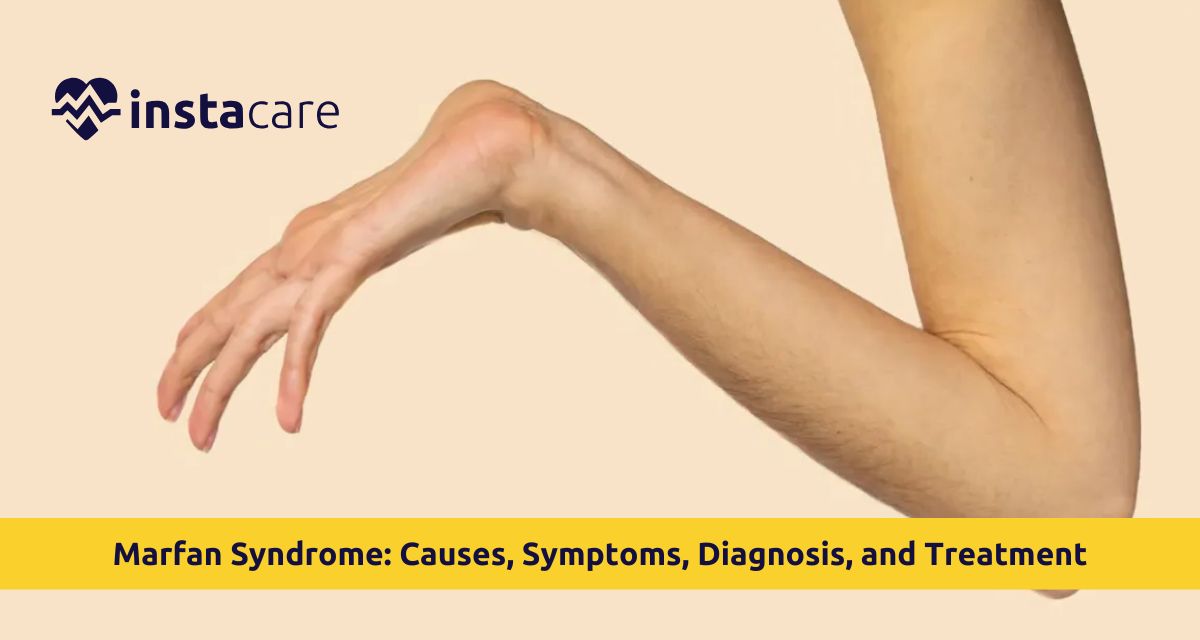Marfan Syndrome can either be fatal or nonfatal. Some are provided with little bodily deviation, while others experience extreme complications targeting the eyes and heart. Quality and control of life can only be guaranteed by knowledge about the Marfan syndrome causes, symptom, diagnosis, and Marfan syndrome treatment.
What is Marfan Syndrome?
Marfan Syndrome is a genetic disease caused by the mutation product of the gene coding for fibrillin-1, which is one of the major proteins of the strength of the connective tissue. The mutation results in disorganization of the normal development of the connective tissue and leads to brittle bones, ligaments, arteries, and other organs.
It occurs at an incidence of about 1 per 5,000 worldwide, irrespective of gender and race. Due to the very variable presentation in hundreds of patients, they are mostly unsuspected until when complications arise. Marfan Syndrome can be diagnosed early and treated appropriately to allow patients to have normal active lives.
Causes of Marfan Syndrome
Its primary aetiology is genetic. Approximately 75% occur as the result of Inheritance of Marfan syndrome by a single affected parent, and 25% are the consequence of a de novo mutation of the FBN1 gene with no family history.
Gene mutation causes loss of strength of connective tissue and initiation of synthesis of a protein called transforming growth factor-beta (TGF-β) to cause defective skeleton, cardiovascular, and ocular development.
Family history is the strongest risk factor. 50% chance of the child inheriting this defect in case a parent carries the defective gene. Genetic counseling would be strongly advised to family history individuals for Living with Marfan syndrome.
Marfan Syndrome Symptoms
Marfan syndrome symptoms affect more than one body system, and highly variable expression is seen from person to person. They are:
Marfan syndrome skeletal features
- Slender body habitus
- Long fingers and toes, arachnodactyly (long arms and legs)
- Peculiar chest, sunken chest (pectus excavatum) or jutting chest (pectus carinatum)
- Loose joints and flat feet
Marfan syndrome eye problems
- Nearsightedness (myopia)
- Lens dislocation (ectopia lentis)
- Premature cataracts or glaucoma
- Risk of retinal detachment
Blood vessel and Marfan syndrome and heart problems
- Aortic aneurysm, enlargement of the aorta
- Emergency aortic tear, aortic dissection
- Mitral valve prolapse, heart rhythm disorders cause
- Increased risk of sudden cardiac complications
Other Symptoms
- Stretch marks on the body but not caused due to weight variation
- Spontaneous pneumothorax, a pulmonary condition
- Cardiovascular fatigue that is developed due to cardiovascular stress
These Early signs of Marfan syndrome must be diagnosed so that a timely medical treatment can be administered to them.
Diagnosis of Marfan Syndrome
Marfan Syndrome is challenging to diagnose because its appearance overlaps with other connective tissue diseases, including Ehlers-Danlos Syndrome. Marfan syndrome vs Ehlers-Danlos Diagnosis is established following a combination of clinical assessment, imaging, and family screening.
Physical Examination
Doctors are monitoring body proportion, joint mobility, chest shape, and spinal curvature. Doctors are also detecting heart murmurs or arrhythmia.
Genetic Testing
Diagnostic FBN1 gene mutation test is employed to make the diagnosis. It is especially beneficial in family history of Marfan Syndrome.
Imaging Tests
- Echocardiogram – to evaluate heart valves and size of aorta.
- MRI or CT scan – to evaluate for aortic enlargement or dissection.
Eye Examination
Eye specialist evaluates for dislocation of lens, cataract, glaucoma, or retinal defect on slit-lamp examination.
All of these tests collectively provide clear evidence of Marfan Syndrome diagnosis and allow physicians to schedule long-term follow-up.
Complications of Marfan Syndrome
Marfan Syndrome, if left untreated, can cause serious disease complications. Its most common complications include:
- Cardiovascular complications: Death due to rupture aneurysm or aneurysm.
- Vision complications: Blindness resulting from uncorrected subluxation of the lens or retinal detachment.
- Skeletal complications: Malignant scoliosis can cause respiratory disease and immobilization.
- Pregnancy complications: Aside from that, Aside from that, Marfan Syndrome is also fraught with the risk of rupture of the aorta during pregnancy.
Marfan Syndrome conditions pose a challenge to everyday medical monitoring and lifestyle adjustment.
Treatment Options for Marfan Syndrome
There is no treatment at present but treatment is focused on symptom Marfan syndrome management, risk reduction, and prevention of Marfan Syndrome complications. There are various types of therapy:
Medications
- Beta-blockers – to decrease blood pressure and aortic pressure.
- Angiotensin receptor blockers (ARBs) – for controlling enlargement of the aorta.
Surgery
- Repair or replacement of the aorta when it is too enlarged.
- Surgery in severe mitral valve prolapse.
- Skeletal surgery for correction of spinal or chest deformity, producing medical disease.
Eye Care
- Eyeglasses or contact lenses for corrective refractive vision.
- Operation to correct the replacement of the lens or retina.
Management of Lifestyle
- Avoidance of too many sports that place extra stress on the heart.
- Preventive eye, bone, and heart examination.
- Healthy weight and diet.
Effective treatment of Marfan Syndrome program benefits the patients immensely in improving quality and life.
How is it to Live with Marfan Syndrome?
Marfan Syndrome demands change in life, doctor's appointments, and mental toughness. The majority of the patients lead successful lives if treated and continue their life.
- Education and education help the patients to identify symptoms at an early stage and take the doctor's advice.
- Support groups also give emotional support along with peer human reinforcement.
- Personal adjustments like avoidance of excessive physical strain and moderation of heart conditions prevent risks.
Despite problems, medical treatment has enhanced Marfan Syndrome life to the point where most of the patients have nearly normal life spans.
Conclusion
It is an eye, heart, skeletal, and connective tissue syndrome and therefore it is a life-long syndrome. It cannot be cured till date, but early diagnosis of Marfan Syndrome with prophylactic treatment and diet correction can certainly reduce the incidence of fatal complications such as cardiac deformities, skeletal deformities, and blindness to a large extent. Early clinical screening, early treatment, and follow-up all contribute immensely to the quality of life.
With the knowledge of etiology, symptoms, complications, and treatment, patients and families are better equipped to make more informed decisions that result in healthier outcomes. Technology and medical advancements in therapy and science only serve to bring this Genetic disorder Marfan syndrome more advanced treatment, with cures ever on the immediate horizon. With increased awareness and treatment, Marfan Syndrome patients live healthier, more productive, and longer lives.
Please book an appointment with the
best Cardiologist in Lahore, Karachi, Islamabad, and all major cities of Pakistan through
InstaCare, or call our helpline at 03171777509 to find a verified doctor for your disease.

